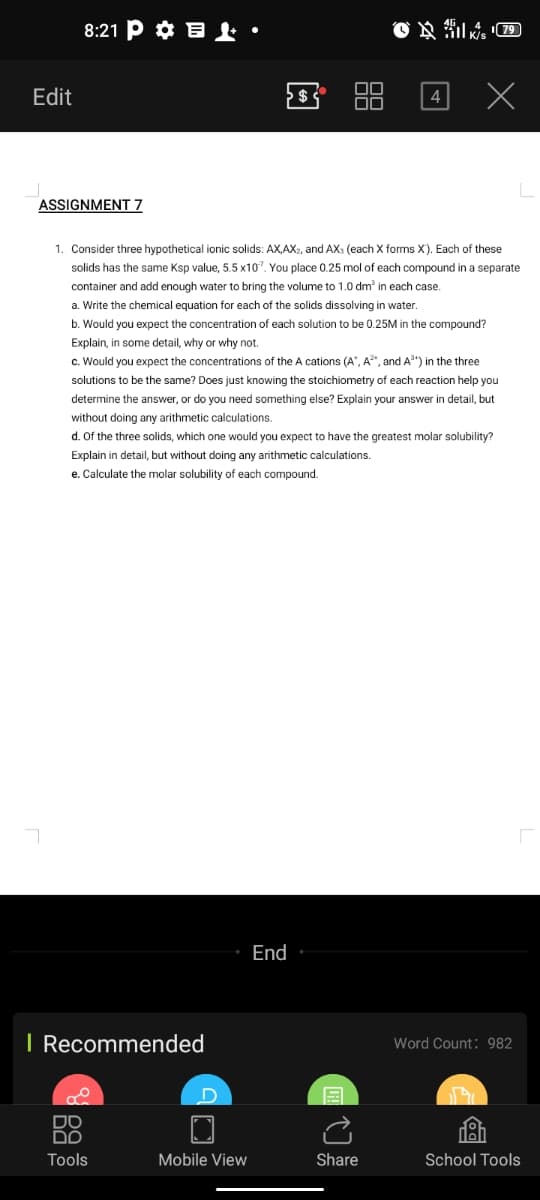1. Consider three hypothetical ionic solids: AX,AX:, and AX: (each X forms X). Each of these solids has the same Ksp value, 5.5 x10". You place 0.25 mol of each compound in a separate container and add enough water to bring the volume to 1.0 dm in each case. a. Write the chemical equation for each of the solids dissolving in water. b. Would you expect the concentration of each solution to be 0.25M in the compound? Explain, in some detail, why or why not. c. Would you expect the concentrations of the A cations (A', A", and A") in the three solutions to be the same? Does just knowing the stoichiometry of each reaction help you determine the answer, or do you need something else? Explain your answer in detail, but without doing any arithmetic calculations.
1. Consider three hypothetical ionic solids: AX,AX:, and AX: (each X forms X). Each of these solids has the same Ksp value, 5.5 x10". You place 0.25 mol of each compound in a separate container and add enough water to bring the volume to 1.0 dm in each case. a. Write the chemical equation for each of the solids dissolving in water. b. Would you expect the concentration of each solution to be 0.25M in the compound? Explain, in some detail, why or why not. c. Would you expect the concentrations of the A cations (A', A", and A") in the three solutions to be the same? Does just knowing the stoichiometry of each reaction help you determine the answer, or do you need something else? Explain your answer in detail, but without doing any arithmetic calculations.
Chemistry: Principles and Practice
3rd Edition
ISBN:9780534420123
Author:Daniel L. Reger, Scott R. Goode, David W. Ball, Edward Mercer
Publisher:Daniel L. Reger, Scott R. Goode, David W. Ball, Edward Mercer
Chapter14: Chemical Equilibrium
Section: Chapter Questions
Problem 14.67QE
Related questions
Question

Transcribed Image Text:8:21 P ¢ Bt•
Edit
> $
4
ASSIGNMENT 7
1. Consider three hypothetical ionic solids: AX,AX2, and AX: (each X forms X). Each of these
solids has the same Ksp value, 5.5 x107. You place 0.25 mol of each compound in a separate
container and add enough water to bring the volume to 1.0 dm in each case.
a. Write the chemical equation for each of the solids dissolving in water.
b. Would you expect the concentration of each solution to be 0.25M in the compound?
Explain, in some detail, why or why not.
c. Would you expect the concentrations of the A cations (A", A", and A") in the three
solutions to be the same? Does just knowing the stoichiometry of each reaction help you
determine the answer, or do you need something else? Explain your answer
detail, but
without doing any arithmetic calculations.
d. Of the three solids, which one would you expect
have the greatest molar solubility?
Explain in detail, but without doing any arithmetic calculations.
e. Calculate the molar solubility of each compound.
End
| Recommended
Word Count: 982
DD
Tools
Mobile View
Share
School Tools
88
Expert Solution
This question has been solved!
Explore an expertly crafted, step-by-step solution for a thorough understanding of key concepts.
This is a popular solution!
Trending now
This is a popular solution!
Step by step
Solved in 2 steps with 2 images

Knowledge Booster
Learn more about
Need a deep-dive on the concept behind this application? Look no further. Learn more about this topic, chemistry and related others by exploring similar questions and additional content below.Recommended textbooks for you

Chemistry: Principles and Practice
Chemistry
ISBN:
9780534420123
Author:
Daniel L. Reger, Scott R. Goode, David W. Ball, Edward Mercer
Publisher:
Cengage Learning

Chemistry & Chemical Reactivity
Chemistry
ISBN:
9781337399074
Author:
John C. Kotz, Paul M. Treichel, John Townsend, David Treichel
Publisher:
Cengage Learning

Chemistry & Chemical Reactivity
Chemistry
ISBN:
9781133949640
Author:
John C. Kotz, Paul M. Treichel, John Townsend, David Treichel
Publisher:
Cengage Learning

Chemistry: Principles and Practice
Chemistry
ISBN:
9780534420123
Author:
Daniel L. Reger, Scott R. Goode, David W. Ball, Edward Mercer
Publisher:
Cengage Learning

Chemistry & Chemical Reactivity
Chemistry
ISBN:
9781337399074
Author:
John C. Kotz, Paul M. Treichel, John Townsend, David Treichel
Publisher:
Cengage Learning

Chemistry & Chemical Reactivity
Chemistry
ISBN:
9781133949640
Author:
John C. Kotz, Paul M. Treichel, John Townsend, David Treichel
Publisher:
Cengage Learning

Chemistry
Chemistry
ISBN:
9781305957404
Author:
Steven S. Zumdahl, Susan A. Zumdahl, Donald J. DeCoste
Publisher:
Cengage Learning

Chemistry: An Atoms First Approach
Chemistry
ISBN:
9781305079243
Author:
Steven S. Zumdahl, Susan A. Zumdahl
Publisher:
Cengage Learning
